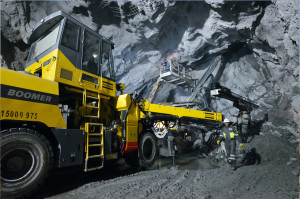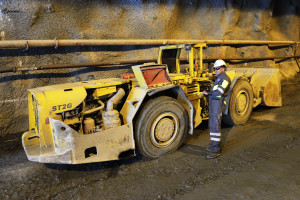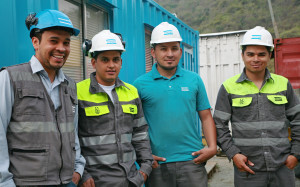Phase I of the Ituango hydropower project consisted of preliminary construction work including an access road to the site, a river diversion and an access tunnel to the underground area. Phase II comprises the main civil engineering works being handled by CCC Ituango, a consortium formed by Brazil?s Camargo Correa and Colombian firms Constructora Conconcreto and Coninsa Ramon H.
The consortium was awarded the contract, valued at USD 1 billion, in August 2012 and just three months later placed an order with Atlas Copco for the necessary equipment.
CCC Ituango is by no means new to the world of energy; the same companies worked together in 2010 on the construction of Porce III, another EPM hydroelectric project in the Antioquia region, about 90 km north east
of Medellin.
?This is the second time we have worked together,? confirms Commercial Director Rafael Borgo. ?The main advantage is not just that we know each other and the way we work, but also the confidence that we now have between the individual companies.?
 He adds that Porce III, which started commercial operations in 2010, is also owned by the utility EPM and was finished and handed over on time.
He adds that Porce III, which started commercial operations in 2010, is also owned by the utility EPM and was finished and handed over on time.
Says Borgo: ?We are expected to do the same here so to be able to meet this commitment in a project of this magnitude we need to work with reliable manufacturers and equipment; machines we already know and a company that can provide us with the after sales service we need; that?s why we?ve decided to use Atlas Copco.?
The project is located between Toledo, Briceño and Ituango about 170 km north of Medellin, the capital of the Antioquia region, and is being built along the Cauca River. Here, at an area known as the Cauca Canyon, the 1?350 km long river flows between steep banks and descends almost 800?m.
The dam will be located some 8 km downstream from the Pescadero Bridge, and immediately upstream from the discharge of the Ituango River into the Cauca River. At this spot, the powerful waters have an average flow of 1 010 m3/s.
The project area is accessed via two main roads, including the 38 km road which was part of the preliminary construction work; this runs along the left bank of the Cauca
River and building it was no easy task.
?The mountainous topography is a big challenge as it makes access very complicated,? says Rogerio Beloni, CCC Ituango Maintenance Director. ?Although some roads are now paved, they?re very narrow and have lots of bends and to make them wider, the earthmoving work required would be huge and costly.? He adds that it was difficult to transport the large equipment and some items even had to be taken apart and then re-assembled on site.
At present, another road is being built from Valdivia Port to Ituango in order to transport the largest items such as the turbines and generators that will arrive when the project is nearly finished and enters its third phase.
Varying ground conditions
The ground is generally a mixture of rock and soil and the conditions at each worksite are classified on a scale of
1 to 5, where 1 is the optimum and 5 is poor. Beloni says: ?There are areas that are not very stable, especially in the inclines, which can be prone to landslides in the winter months. Although they?re not major ones, we have to take this into account in our planning.? In addition, some geological faults have been found underground in some of the caverns which can make excavation difficult.
An important step in the project was the temporary diversion of the Cauca River which was achieved in February this year using two parallel horseshoe-shaped tunnels located on the right bank of the river. These tunnels are 1?090 and 1?215 m long, 14 m in height and 14 m wide.
Dam, reservoir and powerhouse
The current phase of the project includes construction of the dam, spillways, reservoir, power stations and all other related civil works.
The 225 m high dam will be an ECRD-type construction (earth and clay fill) featuring a 550 m long crest and a total volume of 20.1 million m3. It will have a controlled, open flow channel spillway with a discharge capacity of 22?600 m3/s.
Featuring five radial gates and an intermediate discharge tunnel to control the filling of the reservoir, the spillway has a total length of 405 m, a canal width of 70?95 m and is built on a 12.5% slope. There will also be four cofferdams ? two downstream and two upstream. The 79 km long reservoir will have a flood area of 3?800 ha and an active capacity of 980 million m3.
Located underground and accessed by a 950 m long tunnel, are four main caverns: one for the powerhouse which will house eight Francis-type 300 MW turbines, one to house 25 transformers, and two surge chambers equipped with four generators each (see diagram below).
The main cavern is 240 m long, 23?m wide and 49?m high, representing an excavation of approximately 270?000 m3.
After passing through the turbines, the water will flow downstream to the surge chambers and then discharge into the Cauca River via four tailrace tunnels, two from each surge chamber about 1?400 m downstream from the intake site.
New drilling fleet
The new Atlas Copco fleet at Ituango includes seven Boomer drill rigs of various models with one, two or three-booms; 15 FlexiROC T35 drill rigs; four Diamec 262 (now Diamec U6) core drilling rigs, three Scooptram ST2G loaders; four
GA 132 and two GA 160 electric compressors; four XAS 375 JD, two XAS 750 JD diesel compressors and a number of QLT M10 lighting towers. In addition, Atlas Copco provides training for the drill rig operators to complement the contractors? own training programs.
Beloni says: ?We have people here who worked in Porce III and have experience with some of the equipment but also people without experience at all who are being trained here. This way they learn at work and acquire a new skill.?
The Boomer rigs (Boomer?XE3?C, XL3?C, E2 C, L2?C, L2?D, S1?D and T1?D) are all working underground. ?I?ve been drilling all over the caverns with this machine,? says Luis Alfonso Rodriguez, operator of a Boomer XE3 C. A local from Antioquia, Rodriguez has seven years of experience as an operator, some of which he gained at Porce III. There he experienced the Rig Control System (RCS), which allows several levels of automation ? Basic, Regular, and Total. The rigs on the site are equipped for the Total level.
?It was easy to understand and to explain to the trainee operator ? he got it straightaway,? says Rodriquez, referring to Jorge Andres Flores, the trainee now under his wing and who is also from the local area.
The machine is currently drilling 4?m blastholes with 51 mm drill bits, and according to Rodriguez, it takes about an hour to drill and blast one round as the rock conditions at the site are Type 4 (quite poor). But he is happy with the equipment. ?This is a great, powerful machine, better than the previous one I worked with,? he says. ?What I like the most is the visibility from the cabin so I can really see what I?m doing.?
A variety of support methods are employed including steel arches, shotcrete, mesh and rock bolting and some of the Boomer rigs are being used for the installation of 12 m long resin rock bolts.
Mario Restrepo, CCC Ituango?s Underground Excavation Manager, comments: ?As a direct user of Atlas Copco underground equipment I can say that these efficient machines are at the forefront of underground technology. I think this confirms the general perception of excellence that is associated with the Atlas Copco brand.?
Full on for FlexiROC
The FlexiROC?T35 (formerly ROC?D7) tophammer surface drill rigs, which are designed for high performance in demanding construction applications, are also being put through their paces. ?In the surface area we are currently excavating about 12?000?m3 of rock per day in two 12-hour shifts,? says Jose Paulo Fernandes, CCC Ituango?s Production Coordinator, Surface.
He explains that they initially used three FlexiROC T35 rigs that came from Porce III. These rigs worked at Ituango for about a year. Now, of the 15 new FlexiROC rigs, 12 are working on the excavation of the spillway area drilling blastholes, bolt holes and holes for drainage, two are working underground and one is on standby.
?Right now I?m drilling 9 m bolt holes and can install 30 to 40 bolts in one shift,? says Mariano de Jesus Gomez Atehortua, one of the operators working in the spillway area. Due to the mixed quality of the rock it takes him about 20 minutes per bolt.
He previously operated a ROC?D7 rig and is now being trained on the FlexiROC. ?The FlexiROC is more modern, but I had no problem learning all the controls,? he says. ?I prefer this one though, it makes me feel safe. Also, it?s powerful, bigger and much more comfortable.?
Controlled excavation
Fernandes confirms that all of the machines are working well. ?We had planned to excavate a total of 336?000 m3 during March and that?s what we achieved.?
 The other two FlexiROC rigs are working underground in the powerhouse and surge chamber. ?It?s as if they were drilling on the surface, only it is inside a cavern,? says Fernandes, explaining that excavation is less as it is more controlled.
The other two FlexiROC rigs are working underground in the powerhouse and surge chamber. ?It?s as if they were drilling on the surface, only it is inside a cavern,? says Fernandes, explaining that excavation is less as it is more controlled.
?We do between 1?500 and 1?700 m3 per day. Blasting underground is also easier as we don?t have any interference problems like in surface drilling where we have to cordon off an area and wait for it to be clear.?
The four Diamec rigs in the fleet are being used for geological investigations.These compact rigs make them ideal for underground core drilling and the modularized system of rig, power unit, flushing pumps and control panel means that they can be used in surface applications as well as underground.
?They?re good machines,? says Beloni. ?We?ve already used them inside the caverns and outside in the spillway area, and right now they?re working in the adduction channel above the spillway.?
Along with the drill rigs, Atlas Copco compressors and lighting towers help to keep the operations running smoothly. The QLT H40 lighting towers feature a metallic enclosure with an electrical cubicle for control and protection; a hydraulically raised mast that extends vertically up to 9.2 m in 15 seconds and rotates 350°, stabilization legs and brakes.
The towers and diesel compressors are used everywhere there is no fixed electric power. Beloni says: ?Now that we?ve built the fixed compressed air facilities, we only use them sporadically, but at the beginning of the project when we had no energy points, we used them a lot.?
Maintenance and technical support
CCC Ituango has a Maintenance & Parts Contract in place whereby Atlas Copco supports the project?s own maintenance department with all of the drilling, loading and exploration equipment.
?We provide constant onsite technical support, with both preventative and corrective maintenance service, and help with the sourcing and installation of original parts when required,? explains Darwin Cruz, Atlas Copco Service Agreement Manager. For the maintenance of the rest of the fleet, such as compressors and lighting towers, the site is supported by Atlas Copco technicians in Medellin or Bogota.
Cruz?s team for Ituango includes 13 service technicians plus support staff. In each of the two shifts at the project there are always six technicians on the site where they have offices, containers for storage of key spare parts and one used as a workshop for maintenance of the rigs.
Cruz explains that due to the high utilization in such a demanding application, it is the FlexiROC T35 rigs that need more attention. As for the equipment working underground, he notes that the booms on two of the Boomers have been affected by rock falls in a few areas inside some of the tunnels. ?But that?s why we?re here 24 hours a day with our technicians and expertise,? he says. ?Our job is to provide a speedy and effective maintenance service for any need that comes up during the construction of this challenging and exciting project.?
Rock tools and grinding
Atlas Copco supplies all the drill steel for the entire equipment fleet as well as a grinding service for all of the rock drilling tools. This is headed up by Drilling Tools Supply and Grinding Manager Damian Saldarriaga. The team has four containers on site, one used as an office, two for storage of rock tools and another as a grinding center.
There are two grinding technicians, one per shift, using Secoroc?s Grind Matic BQ03, a machine specially designed for threaded and tapered bits with spherical and ballistic buttons. Grinding goes hand in hand with production both on the surface and underground.
?Every day we grind about 600 bits,? says Saldarriaga. ?We also have small, portable grinding machines available as back-up. Our job is to guarantee the continuity of the service at all costs.?
Each rock drilling tool delivered is identified according to a specific code which helps to follow the performance of each individual tool. Explains Saldarriaga: ?For instance, if a machine is reaching low productivity levels, we go to the field, inspect it and analyse what factors are influencing the lifespan of the tool. We can then give accurate feedback to our client about meters drilled and the reason for replacement. The final objective is to help improve our client?s productivity so that they get the lowest cost per meter drilled.?
Service and interaction
Monitoring the performance of each individual tool is possible due to a special software developed in Colombia and used at Porce III. This was later improved and developed into a cost-per-drillmeter contract in the first phase at Ituango. ?The results were good so we developed this newer version to achieve better service for the client,? says Julio Cobos, Atlas Copco product manager for rock drilling tools. This kind of service is very important to CCC Ituango?s managers who value fast maintenance responses, communication, and interaction.
 ?We are talking a lot with both the maintenance and drilling tools teams and their performance has improved considerably,? says Fernandes. ?We believe these contracts, apart from supplying parts and tools, should also be about teaching people, looking at how the equipment is performing and how we?re working. The biggest cost is explosives and drilling tools. If we don?t manage them well, we?re dead!?
?We are talking a lot with both the maintenance and drilling tools teams and their performance has improved considerably,? says Fernandes. ?We believe these contracts, apart from supplying parts and tools, should also be about teaching people, looking at how the equipment is performing and how we?re working. The biggest cost is explosives and drilling tools. If we don?t manage them well, we?re dead!?
?For us it was a matter of reliability in the equipment,? concludes Beloni. ?We work with other brands too, but we always try to work with a reliable manufacturer. Atlas Copco is a well known brand, has reliable equipment and good after sales support, and that is very, very important for us.?
Epiroc operated under the trademark “Atlas Copco” prior to January 1, 2018.





Here:
Us: